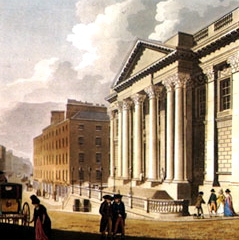Thomas Cooley (architect) on:
[Wikipedia]
[Google]
[Amazon]
 Thomas Cooley (1740–1784) was an English-born Irish architect who came to Dublin from London after winning a competition for the design of Dublin's Royal Exchange in 1768.
Thomas Cooley (1740–1784) was an English-born Irish architect who came to Dublin from London after winning a competition for the design of Dublin's Royal Exchange in 1768.
 Thomas Cooley (1740–1784) was an English-born Irish architect who came to Dublin from London after winning a competition for the design of Dublin's Royal Exchange in 1768.
Thomas Cooley (1740–1784) was an English-born Irish architect who came to Dublin from London after winning a competition for the design of Dublin's Royal Exchange in 1768.
Early years
Cooley was born to William and Mary Cooley inLondon
London is the capital and List of urban areas in the United Kingdom, largest city of England and the United Kingdom, with a population of just under 9 million. It stands on the River Thames in south-east England at the head of a estuary dow ...
and began his career as a carpenter apprenticeship in 1756 with interest in architecture.
Cooley worked as a draughtsman and clerk to the architect and engineer Robert Mylne (1733–1810), while the latter was building Blackfriars Bridge
Blackfriars Bridge is a road and foot traffic bridge over the River Thames in London, between Waterloo Bridge and Blackfriars Railway Bridge, carrying the A201 road. The north end is in the City of London near the Inns of Court and Temple Ch ...
in London, between 1761 and 1769. In 1769, he won the competition to design a new Royal Exchange in Dublin, and the building, now the City Hall, was completed in 1779. The design shows the influence of Mylne's work, which in turn derived from French neoclassical architecture.
Architecture career and Ireland
Arriving in Ireland in 1768, Cooley built several public buildings inDublin
Dublin (; , or ) is the capital and largest city of Ireland. On a bay at the mouth of the River Liffey, it is in the province of Leinster, bordered on the south by the Dublin Mountains, a part of the Wicklow Mountains range. At the 2016 c ...
in the neoclassical style. Together with James Gandon
James Gandon (20 February 1743 – 24 December 1823) was an English architect best known for his work in Ireland during the late 18th century and early 19th century. His better known works include The Custom House and the surrounding Beresford ...
(1743–1823), Cooley was part of a small school of architects influenced by Sir William Chambers
__NOTOC__
Sir William Chambers (23 February 1723 – 10 March 1796) was a Swedish-Scottish architect, based in London. Among his best-known works are Somerset House, and the pagoda at Kew. Chambers was a founder member of the Royal Academy.
Bio ...
(1723–1796).Summerson (1993), p. 412.
Cooley also designed Newgate Prison (demolished 1893), the Marine School, and a chapel, all in Dublin. In 1768 he began another public building in the city, but on his death at the age of 44 in Dublin, the project was handed over to Gandon, who completed it, to his own design, as the Four Courts
The Four Courts ( ga, Na Ceithre Cúirteanna) is Ireland's most prominent courts building, located on Inns Quay in Dublin. The Four Courts is the principal seat of the Supreme Court, the Court of Appeal, the High Court and the Dublin Circui ...
.
Outside Dublin, Cooley built a number of country houses including Caledon (1779), for James Alexander, later Earl of Caledon
Earl of Caledon, of Caledon, County Tyrone, Caledon in the County of Tyrone, is a title in the Peerage of Ireland. It was created in 1800 for James Alexander, 1st Earl of Caledon, James Alexander, 1st Viscount Caledon. He was a merchant who had ...
. He designed several buildings in Armagh, including the Archbishop's Palace (now the town hall), and the public library.
List of buildings designed or built by Cooley
This is an incomplete list of buildings from Cooley: * St Patrick's Cathedral, 1769 – survey * Headfort, 1769–1771 * Palace Demesne, Archbishop's Palace – remodelling * Sir Rogerson's Quay–Hibernian Marine School, 1770–1773 * Chapel at Phonenix Park, Royal Hibernian Military School, 1771 * Abbey Street Public Library, 1771 *Ardbraccan
Ardbraccan ( ga, Ard Breacáin) is an ancient place of Christian worship in County Meath, Ireland. It is the location of the former residence of the Roman Catholic, then, after the Reformation, the Church of Ireland Bishop of Meath. It is approx ...
, 1772–1775
* Newgate Prison, 1773–1781
* Royal School, College Hill, 1774
* Bishop's Palace, Killaloe, 1774
* Royal Hospital, South Kilmainham, 1775–1777
* The Four Courts
The Four Courts ( ga, Na Ceithre Cúirteanna) is Ireland's most prominent courts building, located on Inns Quay in Dublin. The Four Courts is the principal seat of the Supreme Court, the Court of Appeal, the High Court and the Dublin Circui ...
, Inn's Quay, 1768–1802
* Enlargement of the Linenhall, 1784
Personal
From 1781 Cooley remained in Ireland until the end of his life. He was survived by a son William and a daughter and was predeceased by his wife.References
Sources
*Richardson, Albert E. (2001) ''Monumental Classic Architecture in Great Britain and Ireland''. Courier Dover Publications. *Summerson, John (1993) ''Architecture in Britain: 1530-1830'' 9th edition. Yale. *Jacqueline O'Brien with Desmond Guinness (1994), ''Dublin: A Grand Tour'', Weidenfeld and Nicolson, London. {{DEFAULTSORT:Cooley, Thomas 18th-century Irish architects 18th-century English architects 18th-century Anglo-Irish people Architects from London Architects from Dublin (city) 1740 births 1784 deaths